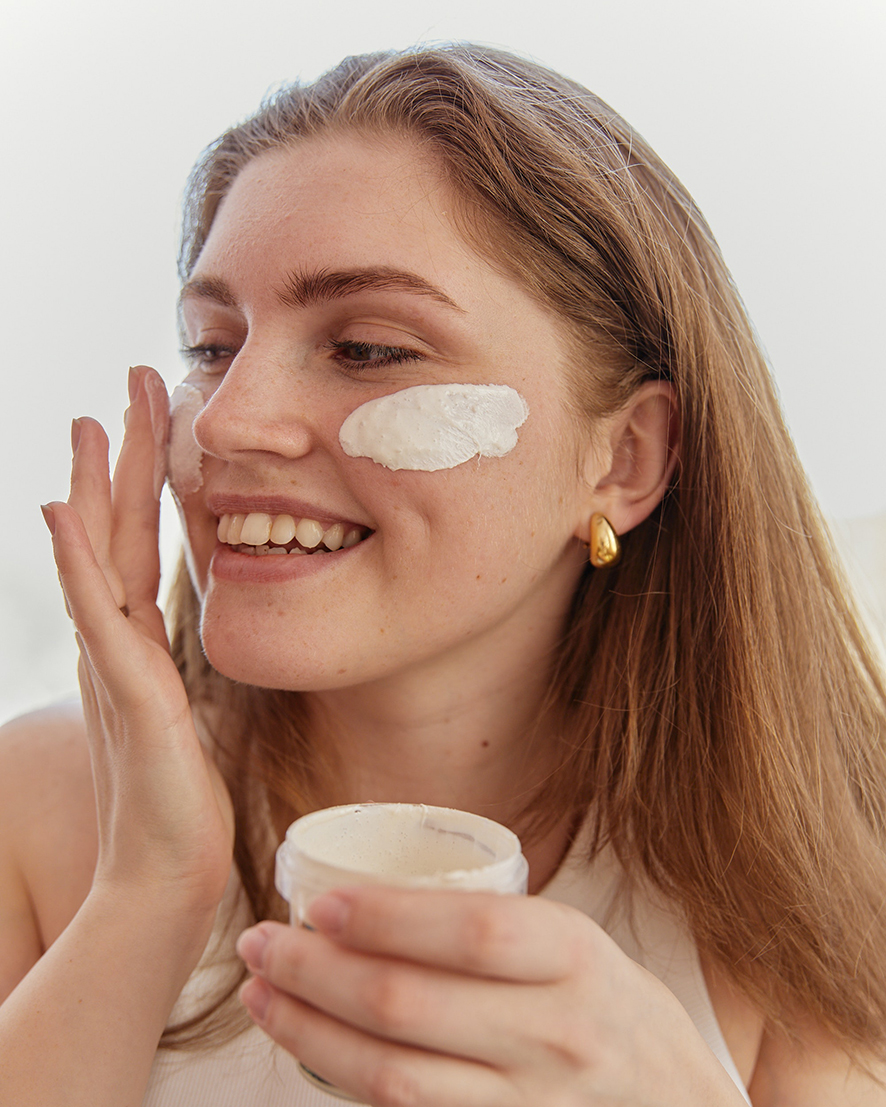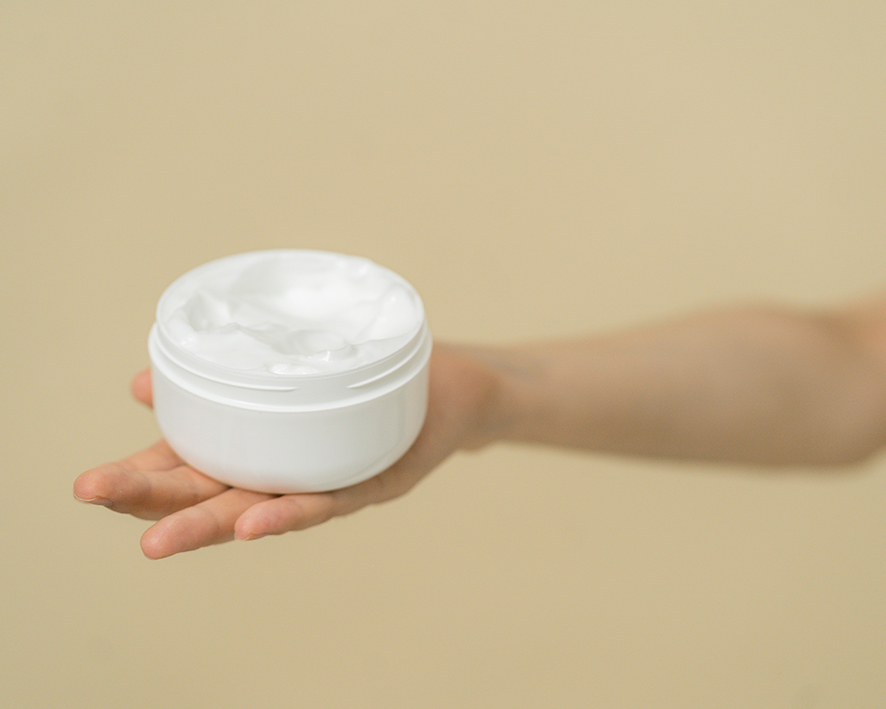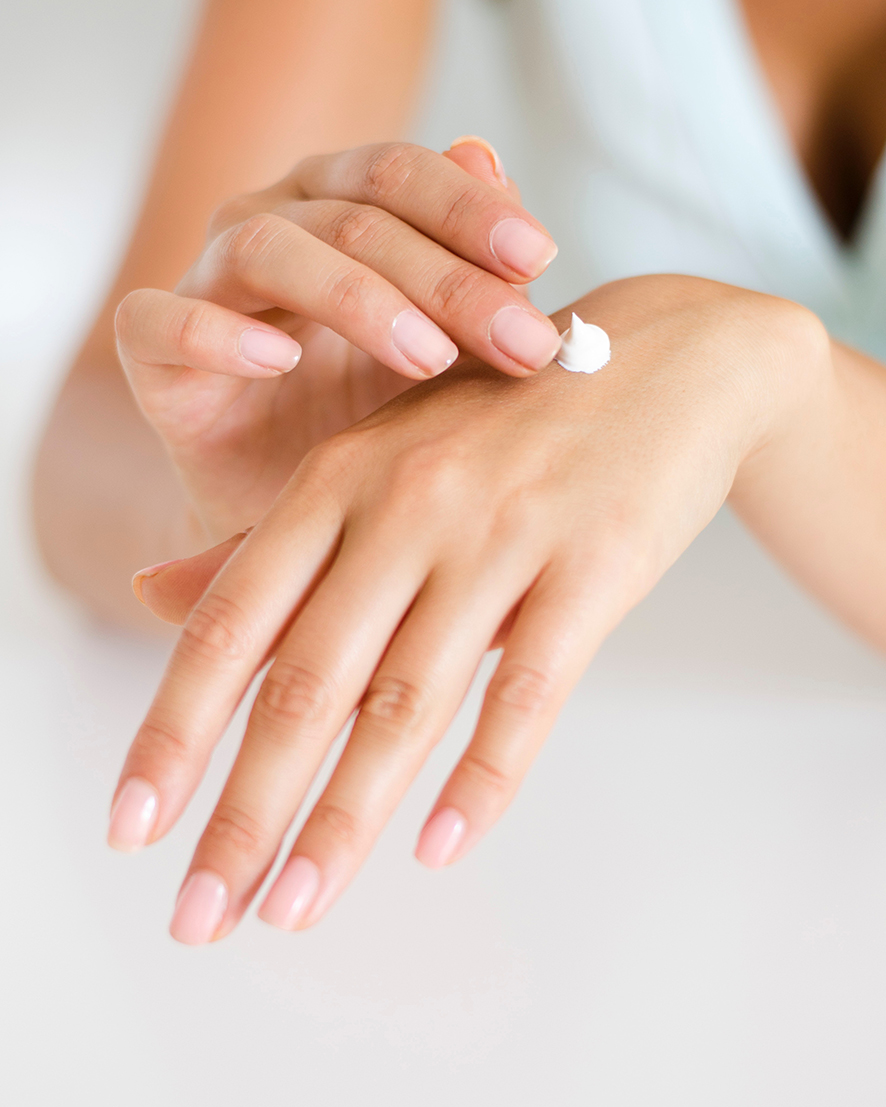Homemade skin cream
The all-weather face cream protects your skin from impurities in the air.
You can also prepare your day cream from the comfort of your own home. Try the recipe for beginners, which combines the basic ingredients necessary to create a creamor be inspired by suggestions on how to vary your homemade lotion or enrich it with active ingredients.

HOMEMADE FACE CREAM - INGREDIENTS
A - aqueous phase
5% Glycerine
80 % Distilled water
B - oil phase
10 % Pistachio oil
4 % Olivem 1000
C - cooling phase
1 % Euxyl PE 9010 - preservative
HOMEMADE SKIN CREAM - PROCEDURE
1. disinfect all utensils and containers that come into contact with the raw materials or product.
2.mix the weighed water and glycerine in a container. In another container, mix the oil and emulsifier.
3. cover the containers with foil and heat in a water bath until the emulsifier dissolves. Olivem 1000 melts at approximately 70 °C.
4.check that both phases are approximately the same temperature and pour the water phase into the oil phase. Immediately start mixing with an immersion stick blender for approximately 1 minute.
5.you can remix the homemade lotion every few minutes while it is cooling, as it cools the lotion will stiffen slightly.
6.add the preservative when the temperature of the mixture drops below 30°C and mix thoroughly.
HOMEMADE SKIN CREAM AND TIPS FOR MAKING IT
Before you put the aqueous phase into the water bath, make a note of its weight. During heating, some of the water may evaporate despite covering the container, so you can top up the missing water after heating is complete. However, do not place the hot beaker or other container directly on the balance; the heat could damage the balance or cause measurement errors. Use a pad or saucer to place the hot container on.
If you want to prolong the freshness of the vegetable oil used and delay its oxidation, you can also add vitamin E to the cream after it has cooled. Thanks to its antioxidant properties, vitamin E helps to slow down the oxidation process, but it is not a preservative (it does not act against micro-organisms). However, if you plan to make your homemade lotion in smaller batches that you can use up quickly, you don't need to add vitamin E unless you currently have it in stock.
If you want to speed up the cooling process, you can place the beaker of premixed emulsion in a cold water bath to cool it down. However, there is a risk that the sudden drop in temperature may cause the cream to curdle and the emulsion to break down, so only use this method if the emulsion hasif you are sure that the emulsion is stable (after the first mixing, the homemade lotion has already thickened slightly and the water is not separating from the oil).

HOMEMADE SKIN CREAM AND ITS COMPOSITION
Only the basic ingredients necessary to create an emulsion are used in the recipe for homemade lotion, so it is suitable for beginners. However, knowing the properties of specific ingredients will help you to understand their role in the lotion, and thus how to vary them.
GLYCERINE
Glycerin is one of the substances that naturally moisturise the skin. It is a syrupy clear liquid that is a common ingredient in many cosmetics, such as homemade face cream. Since it is an alcohol, glycerin is well soluble in water and is added specifically to the aqueous phase.
OLIVEM 1000
A very common emulsifier for homemade lotion, but also other products, is Olivem 1000. Its role is to bind the aqueous and oil components of the product together to form a stable emulsion. It resembles grated wax in appearance and is always added to the oil phase, where it must be dissolved at higher temperatures.
Using an emulsifier, you can slightly control the stiffness and fluidity of your cream. If you want a homemade lotion that is more like a lotion in consistency, reach for lower doses of emulsifier. Conversely, higher percentages of Olivem 1000 will thicken your product.
PISTACHIO OIL
Pistachio nut oil is known for its high vitamin E content. The aforementioned vitamin serves as an antioxidant and aids in skin regeneration. In addition, pistachio oil is rich in minerals and homemade face cream also contains it because it helps to hydrate the skin and fight the signs of aging. It is especially appreciated by dry skin, but it is also suitable for other skin types.
If you find the lotion too oily, just reduce the oil content to about 8%. However, a certain amount of oil must be present in the cream, without it it would no longer be a cream. On the other hand, if your skin would appreciate a more intense lubrication, you can increase the proportion of oil in the recipe. Try a variant with 15% or 20%.
EUXYL PE 9010
This homemade face cream contains Euxyl PE 9010 as a preservative. It is added during the cooling phase so that higher temperatures do not cause it to deactivate. It is active against moulds, yeasts and fungi in a wide pH range and is therefore also suitable for home-made lotion.
Without a preservative, your homemade lotion would only last a few days before it would spoil and microorganisms would multiply in it. In addition to the preservative, you can extend the freshness of the product by storing it in the refrigerator and out of sunlight. To minimize contact with air and product residue, you can use airless bottles, which can be used for lighter creams. This way, you won't scoop your homemade lotion with your fingers, limiting contamination of the rest of the product.

HOMEMADE LOTION AND ITS VARIATIONS
Although the recipe for homemade skin cream only contains the basic ingredients, there is all the more room for you to modify the recipe to suit your needs. You can customize the homemade face cream according to your skin type or add skin care actives to it.
VEGETABLE OILS
Pistachio oil isn't the only one you can use when making a skin cream. There is a wide range of face oils available, from refined ones to organic variants. You can choose an oil for a homemade face cream because of its essential fatty acid, vitamin E or mineral content. You can also combine several types of oils.
EMULGATOR
There are several different emulsifiers on the market suitable for making homemade cosmetics. However, when changing the emulsifier, check the dosage information (in the product description) and the melting point. At the same time, different emulsifiers harden cream products differently, so you may achieve a slightly different consistency and viscosity if you reach for a different emulsifier.
HYDROLATES
Among the easiest substitutions in recipes is replacing water with hydrates. Homemade skin cream contains quite a lot of water, so you can replace all or some of it with a hydrolate. However, when heated, there is a risk of losing the volatiles that give the hydrolates their scent and effects.
SCENTS
If you like scented beauty products, you can also turn your homemade lotion into one. Just add a small amount of essential oil at the cooling stage. Again, observe the dosage for the oils in question, as these are highly concentrated botanicals that can be irritating in the wrong doses.
Essential oils offer a more limited range of scents as not all plants produce these fragrant oils. If you want fruity or various tropical scents, you can reach for synthetically prepared fragrance oils. They are also added at the cooling stage and many times smell very strongly, so a lower dose than the maximum recommended will often suffice.
ACTIVE SUBSTANCES
Last but not least, there are the active ingredients that give many cosmetic preparations their name. In this case, it is really a very wide range of substances with different properties and effects. Many of them are often added in the cooling phase, it may be that some are not compatible for use in creams, so read onstudy information on their use and dosage before including them in a recipe for a homemade skin cream.
CONSERVANTS
Homemade lotion, because of its high water content, requires a preservative as such products are very susceptible to microbial contamination. If you want to substitute a preservative, make sure that it will be active at the pH of the product as well as being broad-spectrum, i.e. it provides protection against bacteria, yeast and fungi.
NOTICE
As mentioned, you can experiment with homemade recipes to achieve desired properties. However, many factors such as humidity, temperature, quality of ingredients and storage can affect the final result.
Before using any raw material to make a cosmetic product, familiarize yourself with its properties, recommended dosage, storage conditions or safe handling. Any raw material may have the potential to cause an allergic reaction in sensitive individuals, so before using a product, we recommend that you find out if you suffer from an allergy to any of the raw materials or the overall product, e.g. by a skin test.
If you have very sensitive or very acne-prone skin, or other skin and health problems, we recommend that you consult a medical professionalbefore applying a new product to your skin, whether it is a homemade cosmetic product, a pure raw material or a commercially available product.
HOME-MADE SKIN CREAM AND CONCLUSION
How many of you already have this lotion at home? No one? Then make it with us by following this tutorial.
In this winter season, extra hydration is just a plus.
If you've tried this tutorial with the homemade lotion making process, let us know how you did. We'll be looking forward to it.
Do the saponification, my friends.


